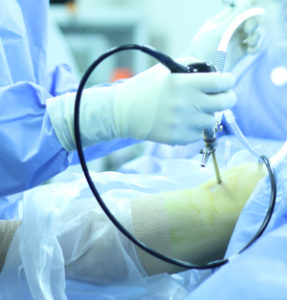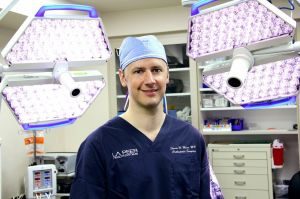Arthroscopic Knee Surgery Los Angeles
By Steven Meier
Knee injuries are ubiquitous – simple missteps, a trip, and fall, sports injuries, wear-and-tear, age-related degeneration can leave you sidelined from daily and athletic activities with debilitating pain and damage to the joint.
Fortunately, advances in medicine have improved prognoses and reduced post-operative recovery times dramatically. One such advance is arthroscopy – minimally invasive surgery using a tiny camera and specialized instruments to perform surgery with smaller incisions and less surgical trauma to the joint. The result? Smaller scars, quicker recoveries, and higher success rates.
Performed more than two million times globally each year, arthroscopic knee surgery, “knee arthroscopy”, often simply referred to as a “knee scope”, has become one of the most common orthopedic surgeries in the world, in large part because of its numerous benefits for patients.
Knee Anatomy
Three bones meet to form the knee joint: the femur (thighbone), tibia (shinbone), and patella (kneecap). Four ligaments – strong, fibrous tissues which connect these bones – provide structure and stability to the joint:
- The anterior cruciate ligament (ACL) and posterior cruciate ligament (PCL) cross through the center of the joint, preventing the shinbone from sliding forward or backward against the thighbone, respectively.
- The medial collateral ligament (MCL) runs along the inside of the knee, preventing the joint from bending inward.
- The lateral collateral ligament (LCL) runs along the outside of the knee, preventing the joint from bending outward.
Where the bones of the knee joint come into contact with one another resides the very important, specialized and delicate tissue called cartilage. There are 2 types of cartilage in the knee. There is the articular cartilage (hyaline cartilage), the slippery gliding tissue that lines the surface of the bones within the joint. And there is also the meniscus cartilage. There 2 menisci in each knee (medial meniscus on the inner part of the knee and the lateral meniscus on the outer portion of the knee.) The meniscus is made of fibrocartilage and serves as a cushion between the femur and tibia. Injuries to the meniscus and articular cartilage are very common and are the most common indications for arthroscopic knee surgery.
What Is Arthroscopic Knee Surgery?
 Arthroscopy – Greek for “to look within the joint” – is a minimally invasive and highly versatile technique used to diagnose, treat, and repair joint injuries. In general, any procedure which uses an arthroscope – a pencil-thin camera that allows surgeons to see and perform procedures without a large open incision – is considered an arthroscopy.
Arthroscopy – Greek for “to look within the joint” – is a minimally invasive and highly versatile technique used to diagnose, treat, and repair joint injuries. In general, any procedure which uses an arthroscope – a pencil-thin camera that allows surgeons to see and perform procedures without a large open incision – is considered an arthroscopy.
Notably, the small instruments of arthroscopy make it easily translatable to a wide variety of joints – the most common being shoulders, knees, elbows, wrists, ankles, and hips – as well as a wide variety of procedures, including both diagnosis and repair.
Arthroscopy Knee Procedure Summary
After anesthesia is applied, a saline solution is pumped into the joint, allowing more room to manipulate tools and better visualization of the procedure. Then, two or three incisions, each only ~six millimeters long (~a quarter of an inch), are made to the area around the joint. The arthroscope is inserted through one of these incisions, and screen through fiber optics, the image is displayed on a video monitor in the operating room, providing the doctor with an enlarged, high-definition view of the internal structures of the knee.
Other small instruments to grasp, shave, sculpt, smooth and or provide suction is inserted through the other incisions to perform the necessary procedure.
Knee Surgery Rehabilitation and Recovery
Patients typically go home the day of the surgery and begin a postoperative rehabilitation program soon after. Rest, ice, compression, and elevation to reduce swelling are also recommended immediately after surgery. Crutches, bracing, and pain medication may be necessary. In most cases, the specific rehabilitation and recovery will depend on the extent of work done on the knee and the exact procedure.
Benefits of Arthroscopic Surgery
 In the past, “open” surgeries, which required large incisions through all layers of skin, tissue, and muscle, were the only option for knee repair. Because of the surgical trauma done to the knee in this process, surgeries were less likely to be successful and recovery was long and painful.
In the past, “open” surgeries, which required large incisions through all layers of skin, tissue, and muscle, were the only option for knee repair. Because of the surgical trauma done to the knee in this process, surgeries were less likely to be successful and recovery was long and painful.
By minimizing the damage done to the knee, arthroscopic surgery provides numerous benefits over traditional open surgery. Most importantly, success rates are as good or better with arthroscopic surgery compared to traditional open surgery. Further, patients have less pain and stiffness, fewer complications, and drastically reduced recovery times – key for active lifestyles and workplaces.
Due to the smaller incisions and reduced damage to the knee, arthroscopy also confers smaller scars and a lessened risk of complications such as infection, blood clots, and inadvertent damage to knee cartilage compared to open surgery. However, as with any surgery, risks still exist and should be discussed with your surgeon prior to any procedure.
Arthroscopic Knee Procedures
Treatment and Repair with Arthroscopy
Meier Orthopedic Sports Medicine offers arthroscopic treatment for a variety of knee injuries. Some of the most common:
- Meniscus surgery. A very common injury among athletes, a torn meniscus can be trimmed to remove nonviable damaged tissue or repaired by suturing viable tissue together arthroscopically.
- Articular cartilage surgery. When damaged, cartilage unfortunately does not normally heal on its own. However, the smoothing of torn cartilage and arthroscopic stimulation of the area through drilling, microfracture, or implantation of new cartilage cells can relieve pain and improve mobility significantly.
- Anterior cruciate ligament (ACL) repair and reconstruction is performed with arthroscopic assistance to minimize incisions, decrease postoperative pain, minimize scar tissue formation and stiffness, allowing accelerated rehabilitation.
Of note, other common surgeries such as medial collateral ligament (MCL) repair or lateral collateral ligament (LCL) repair/reconstruction use arthroscopy to confirm diagnosis and set a surgical plan. However, arthroscopy is not used in the procedure when completing the actual repair.
Diagnosis with Arthroscopy
Surgeons may utilize arthroscopy as a method for diagnosis when traditional imaging tools, such as x-ray or MRI, are inconclusive or unable to elucidate an injury. Sometimes, these traditional methods fall short because they only provide a still image of the knee at one point in time. By comparison, arthroscopy has the distinct advantage of providing a three-dimensional, dynamic, live view of the joint. The knee can also be manipulated by the surgeon while the arthroscope is in to give a better view of an injury and see how it reacts to movement – often key to an accurate diagnosis and treatment decision.
Furthermore, arthroscopy allows for simultaneous diagnosis and treatment of an injury. This is especially beneficial for more nuanced injuries that are difficult to diagnose with a standstill image from an x-ray or MRI, as well as for concomitant injuries that may go unnoticed in initial diagnoses. In other words, arthroscopy affords the surgeon the flexibility to diagnose and treat multiple injuries – previously diagnosed or newly found –without the need for a second procedure.
Citations
1. Siemieniuk, R.A.C., et al. (May 2017). Arthroscopic surgery for degenerative knee arthritis and meniscal tears: a clinical practice guideline. Retrieved from https://www.bmj.com/content/357/bmj.j1982
2. Arthroscopy (August 2018). Retrieved from https://www.mayoclinic.org/tests-procedures/arthroscopy/about/pac-20392974
3. Ma, C.B. (March 2019). Knee Arthroscopy. Retrieved from https://medlineplus.gov/ency/article/002972.htm
4. Wilkerson, R. and Fischer, S.J., (September 2016). Knee Arthroscopy. Retrieved from https://orthoinfo.aaos.org/en/treatment/knee-arthroscopy/

